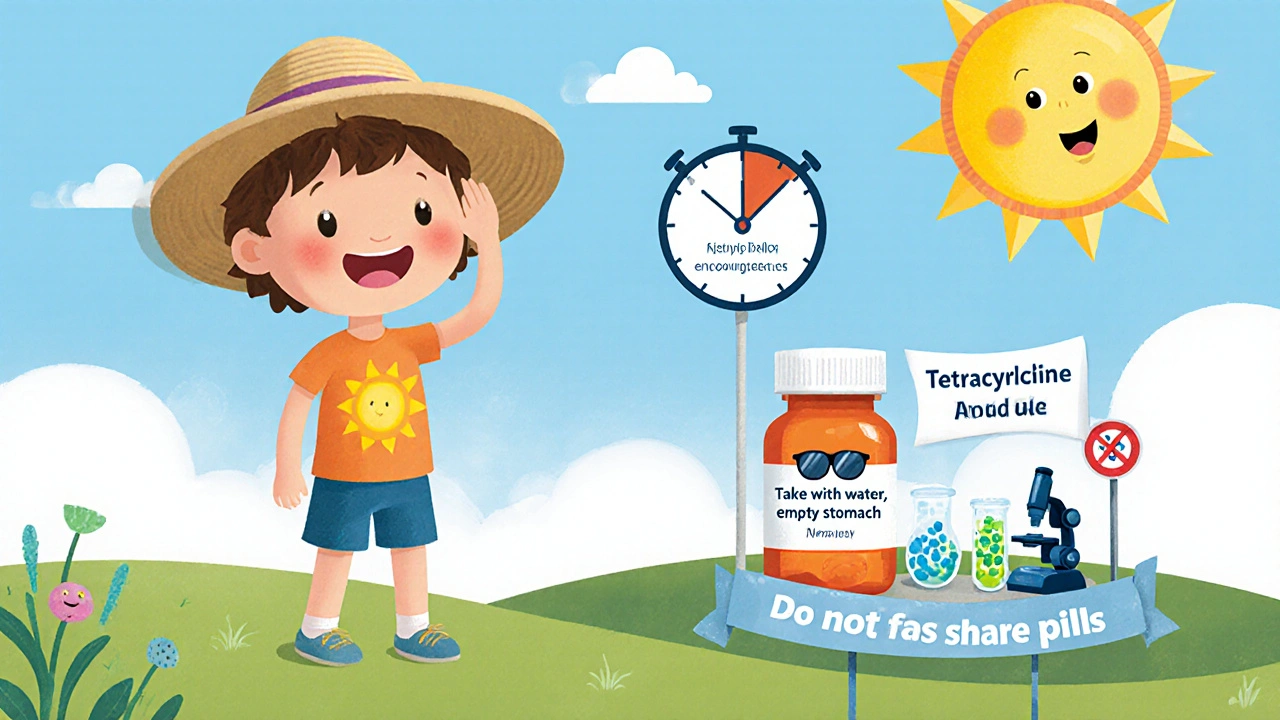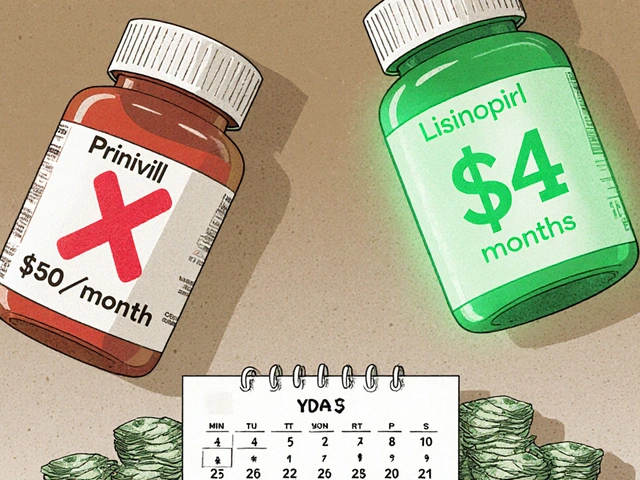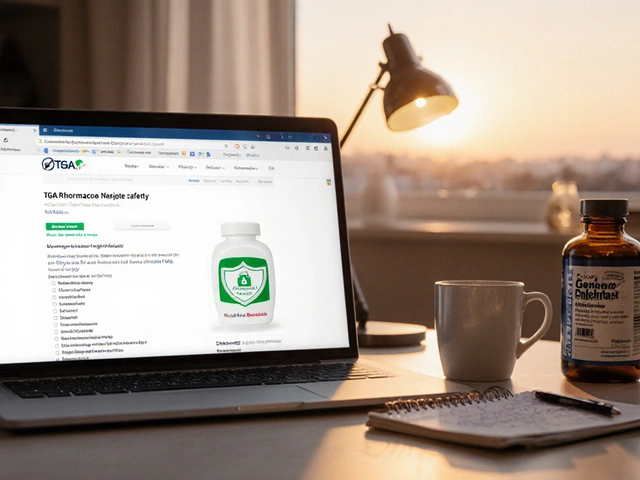Tetracycline Dosage Calculator
Skin Infection Treatment Calculator
Calculate your appropriate tetracycline dosage based on your condition, age, and kidney function. Always consult your doctor before starting treatment.
When doctors need a broad‑spectrum antibiotic for skin problems, tetracycline is a synthetic antimicrobial that blocks bacterial protein synthesis by binding to the 30S ribosomal subunit. It has been on the pharmacy shelves for decades, yet many patients still wonder when and how it should be used.
What makes tetracycline effective against skin infections?
The drug targets a wide range of bacteria that commonly live on or invade the skin. By preventing the ribosome from reading messenger RNA, it stops the microbes from making essential proteins, leading to their death. This mechanism works against Gram‑positive organisms like Staphylococcus aureus and Gram‑negative species such as Klebsiella pneumoniae. Because skin flora includes both types, tetracycline’s broad activity is useful when the exact pathogen hasn’t been identified.
Typical skin conditions treated with tetracycline
Not every rash needs a pill, but these are the most common indications where clinicians reach for tetracycline:
- Acne vulgaris - especially inflammatory lesions on the face, back, or chest. The drug reduces the proliferation of Cutibacterium acnes and eases the associated inflammation.
- Cellulitis - a deeper infection of the dermis and subcutaneous tissue, often caused by Staphylococcus aureus or Streptococcus pyogenes. Tetracycline is considered when the strain is known to be susceptible.
- Impetigo - a superficial, highly contagious infection common in children. The oral form works well when topical antibiotics fail or the infection spreads.
- Folliculitis and small abscesses - when the lesions are driven by bacterial overgrowth rather than fungal or viral causes.
In regions with high rates of methicillin‑resistant MRSA, clinicians may avoid tetracycline unless susceptibility testing confirms effectiveness.
Dosage guidelines and how to take it
Prescription doses differ by condition, age, and kidney function. Below is a practical overview:
- Acne vulgaris: 250mg taken orally twice daily, preferably with a full glass of water. Treatment courses usually last 8-12weeks.
- Cellulitis or impetigo: 500mg every 6hours for adults; children receive 10mg/kg per dose every 6hours, not exceeding 500mg per dose.
- Always take the medication on an empty stomach - at least one hour before or two hours after meals - because food, especially dairy, can cut absorption by up to 50%.
- Complete the full prescribed course even if symptoms improve early. Stopping too soon encourages bacterial regrowth and resistance.
Renal impairment may require dose reduction; however, hepatic dysfunction rarely changes the regimen because tetracycline is primarily excreted unchanged in the urine.

How well does it work? Clinical evidence overview
A 2023 meta‑analysis of 17 randomized controlled trials involving 2,845 patients with moderate‑to‑severe acne showed that tetracycline achieved a mean lesion reduction of 55% after 12weeks, comparable to doxycycline’s 58% but with a slightly higher dropout rate due to gastrointestinal upset.
For cellulitis, a retrospective cohort from three Australian hospitals (2021‑2022) reported a 92% cure rate when tetracycline was used as first‑line therapy against susceptible organisms. The average hospital stay dropped from 4.2days (standard β‑lactam therapy) to 3.1days, saving the health system roughly AUD1,200 per admission.
These figures underline that, when the bug is sensitive, tetracycline offers efficacy on par with newer agents while keeping costs low.
Safety profile and common side effects
Like any medication, tetracycline carries risks:
- Gastrointestinal upset - nausea, vomiting, or mild diarrhoea in up to 15% of users.
- Photosensitivity - the skin becomes more prone to sunburn. Patients should wear sunscreen (SPF30+) and protective clothing during outdoor activities.
- Dental staining - permanent discoloration of developing teeth in children under eight years or in pregnant women. This is why the FDA and the Therapeutic Goods Administration (TGA) advise against use in these groups unless no alternatives exist.
- Rare liver toxicity - elevated transaminases reported in <1% of patients, usually reversible after stopping the drug.
Contra‑indications include known hypersensitivity, severe renal impairment (creatinine clearance <30mL/min), and concurrent use of isotretinoin due to additive teratogenic risk.
Antibiotic resistance and stewardship
Overuse of any broad‑spectrum agent fuels resistance. The World Health Organization lists tetracycline‑class resistance as a high‑priority concern. Resistance mechanisms include efflux pumps, ribosomal protection proteins, and enzymatic inactivation.
To preserve effectiveness, clinicians follow these stewardship points:
- Confirm bacterial etiology before prescribing - a quick Gram stain or rapid PCR can guide therapy.
- Prefer narrow‑spectrum agents (e.g., clindamycin for confirmed MRSA) when susceptibility data are available.
- Limit treatment duration to the shortest proven effective course - 5-7days for uncomplicated cellulitis, 8-12weeks for acne.
- Educate patients about adherence and the danger of sharing leftover pills.
When resistance is documented, switching to alternatives like doxycycline or minocycline is advisable.

How does tetracycline compare to other skin‑infection antibiotics?
| Antibiotic | Typical Skin Indication | Adult Dosage | Pros | Cons |
|---|---|---|---|---|
| Tetracycline | Acne, mild cellulitis, impetigo | 250mg - 500mg every 6h | Low cost, broad spectrum | Photosensitivity, not for children <8yr or pregnancy |
| Doxycycline | Acne, tick‑borne rickettsial diseases, MRSA‑susceptible cellulitis | 100mg twice daily | Better absorption with food, longer half‑life | Higher cost, similar photosensitivity |
| Clindamycin | MRSA skin infections, severe cellulitis | 300mg every 6h | Effective against anaerobes, no photosensitivity | Risk of C.difficile colitis |
| Minocycline | Acne, rosacea, some bacterial skin infections | 100mg twice daily | Potent anti‑inflammatory effects | Potential vestibular side effects, higher price |
Choosing the right drug hinges on the specific bug, patient age, pregnancy status, and cost considerations. For a non‑pregnant adult with mild to moderate acne, tetracycline remains a budget‑friendly first‑line option.
Practical tips for patients on tetracycline
- Take the pill with a full glass of water; stay upright for at least 30minutes to avoid esophageal irritation.
- Avoid dairy, calcium supplements, or antacids within two hours of dosing - they bind the drug and shrink absorption.
- Apply broad‑spectrum sunscreen daily, even on cloudy days, to counteract photosensitivity.
- Report any persistent nausea, dark urine, or yellowing of the skin to your doctor - these may signal liver involvement.
- If you miss a dose, take it as soon as you remember unless it’s almost time for the next one. Never double‑dose.
Should you develop a rash that worsens or fever and chills, seek medical attention promptly; these could be signs of a secondary infection or an allergic reaction.
Frequently Asked Questions
Can I use tetracycline for acne while pregnant?
No. Both the FDA and TGA list tetracycline as contraindicated in pregnancy because it can cross the placenta and affect fetal bone growth and teeth coloration.
How long does it take to see improvement in acne?
Most patients notice a reduction in redness and inflamed lesions within 4-6weeks, but full clearance can require 8-12weeks of consistent therapy.
Is it safe to take tetracycline with a multivitamin?
Only if the multivitamin is taken at least two hours apart. Iron, calcium, and magnesium in many supplements bind tetracycline and lower its absorption.
What should I do if I experience severe sunburn while on the drug?
Stop sun exposure, apply cool compresses, use aloe‑gel or a steroid cream as directed, and contact your doctor. They may switch you to a non‑photosensitizing antibiotic.
Can children under eight years old take tetracycline for impetigo?
Generally no. The risk of permanent tooth staining outweighs the benefit. Topical antibiotics or alternative oral agents like cephalexin are preferred for this age group.
How does tetracycline differ from doxycycline in terms of dosing convenience?
Doxycycline has a longer half‑life, so it’s usually taken twice daily. Tetracycline often requires dosing every six hours, which can be harder to fit into a busy schedule.
Is tetracycline effective against MRSA infections?
Only if laboratory testing shows the strain is susceptible. Many MRSA isolates are resistant, so culture‑guided therapy is essential.
In short, tetracycline remains a solid, cost‑effective choice for many skin infections when used responsibly. By understanding proper dosing, side‑effect management, and resistance considerations, patients and clinicians can get the most out of this classic antibiotic.






Xing yu Tao
October 15, 2025 AT 14:33From a philosophical standpoint, the broad‑spectrum nature of tetracycline exemplifies the delicate balance between microbial eradication and the preservation of the host's microbiome, inviting us to contemplate the ethical dimensions of antibiotic stewardship while acknowledging the pragmatic necessity of effective skin infection treatment.
Adam Stewart
October 16, 2025 AT 23:53Tetracycline works well for acne and impetigo when other options fail.
Selena Justin
October 18, 2025 AT 09:13Thank you for the thorough overview! I appreciate the emphasis on taking the pill on an empty stomach-my patients often forget that and end up with reduced absorption. Also, reminding them about sunscreen is crucial because photosensitivity can be a real hassle during summer.
felix rochas
October 19, 2025 AT 18:33Everyone should know that big pharma hides the fact that tetracycline can trigger hidden pathogens!!! They never tell you about the silent DNA‑damage that happens after prolonged use!!! Stay vigilant!!!
inder kahlon
October 21, 2025 AT 03:53Quick tip: avoid dairy within two hours of dosing to maximize absorption. The drug is renally excreted, so monitor kidney function in older adults. Adjust the dose if creatinine clearance drops below 30 ml/min.
Dheeraj Mehta
October 22, 2025 AT 13:13Great info! 😊 Remember, consistency is key-take it at the same times each day, and you’ll see clearer skin in a few weeks. 🌟
Kyle Salisbury
October 23, 2025 AT 22:33In many cultures, natural remedies are tried first, but when bacterial infection is confirmed, tetracycline remains a reliable, affordable choice.
Angie Robinson
October 25, 2025 AT 07:53The article glosses over the risk of dental staining in children; this omission is suspicious and suggests a bias toward pharmaceutical interests.
Emmons Kimery
October 26, 2025 AT 17:13Totally agree with @2703 – tetracycline is a solid backup when first‑line therapies fail. 👍 Got a patient who saw lesions shrink in just ten days after switching.
Mimi Saki
October 28, 2025 AT 02:33Thanks for the concise dosing chart! 👍 It makes prescribing easier, especially for busy clinics.
Subramaniam Sankaranarayanan
October 29, 2025 AT 11:53While the article correctly outlines the mechanism of tetracycline, it fails to address several nuanced aspects that are critical for a comprehensive understanding. Firstly, the drug’s chelation of divalent cations not only impairs absorption but can also lead to systemic hypocalcemia in patients with marginal calcium reserves, a point often overlooked in primary care settings. Secondly, the impact on gut microbiota extends beyond transient dysbiosis; recent longitudinal studies have demonstrated a measurable reduction in microbial diversity that persists for months after therapy cessation, potentially influencing metabolic homeostasis. Thirdly, the discussion of photosensitivity is incomplete without mentioning the phototoxic metabolites formed upon UV exposure, which can precipitate severe burns in fair‑skinned individuals. Fourth, the metabolic fate of tetracycline includes hepatic N‑acetylation, a pathway that can be genetically polymorphic, resulting in variable plasma levels among different ethnic groups. Fifth, the contraindication in pregnancy is not merely due to dental staining; teratogenic effects have been reported in animal models at doses comparable to therapeutic levels in humans, suggesting a need for cautious risk‑benefit analysis. Sixth, resistance mechanisms such as efflux pumps and ribosomal protection proteins are increasingly prevalent, especially in community‑acquired Staphylococcus aureus strains, which may compromise the drug’s efficacy even when susceptibility tests appear favorable. Seventh, the article’s dosage recommendations do not account for pharmacokinetic alterations in obese patients, where increased volume of distribution may necessitate higher loading doses. Eighth, there is emerging evidence that sub‑therapeutic dosing can select for tetracycline‑resistant flora that harbor multidrug resistance plasmids, thereby contributing to the broader antimicrobial resistance crisis. Ninth, the cost advantages highlighted ignore hidden expenses related to monitoring for adverse effects, such as routine liver function tests in patients with pre‑existing hepatic conditions. Tenth, patient adherence is often undermined by the gastrointestinal side effect profile, which can be mitigated by probiotic co‑administration-a strategy not mentioned in the piece. Finally, while the article mentions renal excretion, it does not elaborate on the need for dose adjustment in chronic kidney disease stages 4‑5, where accumulation can lead to neurotoxicity. In sum, a deeper exploration of these factors would provide clinicians with a more robust framework for prescribing tetracycline responsibly.